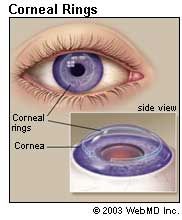
Cornea Structure
To understand potential problems, it helps to know the parts of the cornea. Is has three main layers:
Epithelium. The outermost layer. It stops outside matter from getting into your eye. It also absorbs oxygen and nutrients from tears.
Symptoms of Cornea Problems
The term corneal disease refers to many conditions that affect this part of your eye. These include infections, tissue breakdown, and other disorders you get from your parents.
Your cornea usually heals itself after most minor injuries or infections. But during the healing process, you might notice symptoms like:
- Pain
- Blurred vision
- Tearing
- Redness
- Extreme sensitivity to light
These symptoms also come with other eye problems, so they may signal a more serious issue that requires special treatment. If you have them, go to your eye doctor.
What Conditions Can Cause Damage?
Keratitis: This inflammationsometimes occurs after viruses, bacteria, or fungi get into the cornea. They can get in after an injury and cause infection, inflammation, and ulcers. If your contact lenses cause an eye injury, that, too, can lead to keratitis.
Symptoms to look out for:
- Severe pain
- Blurred vision
- Tearing
- Redness
- Extreme sensitivity to light
- Discharge
Treatment usually includes antibiotic or antifungal eyedrops. Some people need antiviral drugs and steroid eyedrops.
Ocular Herpes ( Herpes of the Eye): Like fever blisters, this viral infection can come back again and again. The main cause is the herpes simplex virus I (HSV I), the same one that leads to cold sores. It can also result from the sexually transmitted herpes simplex virus II (HSV II) that causes genital herpes.
This condition creates sores on the cornea. Over time, the inflammation can spread deeper into your cornea and eye.
- Older adults, especially over 80
- People with a weakened immune system
See your doctor if you have any symptoms. If you’re over 50, get the vaccine.
Corneal Degenerations
There are several types. These diseases can cause problems with the cornea’s structure:
Keratoconus : This disease thins your cornea and changes its shape. It usually starts blurring vision during teenage years and worsens during early adulthood. Changes to the cornea’s curvature can create mild to severe distortion, called astigmatism, and usually nearsightedness. The disease can also cause swelling, scars on your cornea, and vision loss. Your night vision could get so bad you can’t drive after dark.
Causes include:
- Genetics (you can inherit a tendency for the condition from a parent)
- Eye trauma (from rubbing your eyes a lot)
- Eye diseases like retinitis pigmentosa, retinopathy of prematurity, and vernal keratoconjunctivitis, along with Down syndrome, osteogenesis imperfecta, Addison’s disease, Leber’s congenital amaurosis, and Ehlers-Danlos syndrome are associated with keratoconus.
At first, glasses or soft contacts can solve the problem. As the disease goes on, you may need to wear rigid gas permeable lenses. For people with early keratoconus, a procedure called corneal crosslinking can be performed. During the procedure, the doctor instills riboflavin eyedrops and the eyes get exposure to small amounts of UV light. This procedure often prevents worsening of keratoconus and can prevent the need for corneal surgery.
A small number of people with keratoconus will need a cornea transplant. During this procedure, the doctor will replace your damaged cornea with a donated one. This operation is usually successful. But you probably will still need glasses or contacts to see clearly.
Corneal Dystrophies: There are more than 20 of these diseases. They cause structural problems within your cornea. Some of the most common are:
Map-dot-fingerprint dystrophy. This affects the back layer of your epithelium, which separates it from the stroma. It grows irregularly (thick in some places, thin in others). That causes irregularities in your cornea that look like maps, dots, and small fingerprints.
It usually affects adults over 40. It’s usually painless, doesn’t affect your vision, and gets better without treatment. But sometimes the epithelial layer can get worn down and expose the nerves that line your cornea. That causes severe pain, especially when you wake up in the morning. It can also change your cornea’s normal curve and cause astigmatism, nearsightedness, or farsightedness.
As your cornea changes, your vision may get blurry. You may also notice:
- Moderate to severe pain
- Increased sensitivity to light
- Excessive tearing
- A feeling that something is in your eye
Treatments include an eye patch, a soft contact lens “bandage,” eyedrops, ointments, “tacking it down,” or removing the loose layer. This is a minor procedure your doctor can do in her office.
Fuchs’ dystrophy: This inherited condition causes a slow breakdown of endothelial cells and the swelling of the cornea. This makes it harder to remove water from your stroma. Your eye swells and your vision gets worse. Haze and small blisters may appear on the surface.
Signs of the disease may appear in your 30s or 40s, but it takes about 20 years for it to affect your vision. Women get it more often than men.
An early sign: You wake up with blurred vision that slowly clears during the day. As the disease worsens, swelling becomes more consistent and vision stays blurry.
Treatment includes:
- Eyedrops/ointments
- Drying your swollen cornea with a hair dryer (at arm’s length) two or three times a day
- Corneal transplant (full or partial)
Lattice dystrophy: This is abnormal protein fibers in the stroma. It can happen at any age, but early changes can be seen in childhood.
- Prescription eyedrops
- Ointments
- Eye patches
- Corneal transplant
Symptoms may go away with treatment, but over time you may need a corneal transplant. Results of this surgery are usually good, but the condition can come back.

Post a comment